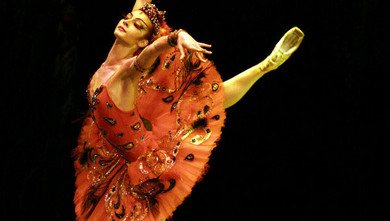an evening of ballet
"Petrouchka"
Music by Igor Stravinsky
Libretto by Vladimir Varnava and Konstantin Fyodorov
Choreographer: Vladimir Varnava
Set and Costume Designer: Galya Solodovnikova
Lighting Designer: Igor Fomin
Petrushka is a ballet burlesque in four scenes. It was composed in 1910–11 and revised in 1947. Igor Stravinsky composed the music, and, with Alexandre Benois, fashioned the libretto. Michel Fokine choreographed the ballet; Benois designed the sets and costumes. Petrushka was first performed by Sergei Diaghilev's Ballets Russes at the Théâtre du Châtelet in Paris on 13 June 1911. Vaslav Nijinsky portrayed Petrushka with Tamara Karsavina as the Ballerina. Alexander Orlov portrayed the Moor, and Enrico Cecchetti the Charlatan.
Petrushka tells the story of the loves and jealousies of three puppets. The three are brought to life by the Charlatan during the 1830 Shrovetide Fair (Maslenitsa) in Saint Petersburg, Russia. Petrushka loves the Ballerina, but she rejects him. She prefers the Moor. Petrushka is angry and hurt, and challenges the Moor. The Moor kills him with his scimitar. Petrushka's ghost rises above the puppet theatre as night falls. He shakes his fist at the Charlatan, then collapses in a second death.
Petrushka brings music, dance, and design together in a unified whole. It is one of the most popular of the Ballets Russes productions. It is usually performed today using the original designs and choreography. Grace Robert wrote in 1946, "Although more than thirty years have elapsed since Petrushka was first performed, its position as one of the greatest ballets remains unassailed. Its perfect fusion of music, choreography, and décor and its theme—the timeless tragedy of the human spirit—unite to make its appeal universal
"The Firebird"
Music by Igor Stravinsky
Libretto by Michel Fokine
Choreography by Michel Fokine (1910)
Reconstruction: Isabelle Fokine, Andris LiepaSet and costume design: Anna and Anatoly Nezhny
after original sketches: Alexander Golovin, Léon Bakst and Michel Fokine
Lighting Designer: Vladimir Lukasevich
ABOUT THE PRODUCTION
I have staged many ballets, but neither with Stravinsky nor with any other composer have I worked so hand-in-glove as on this occasion. (...)
I wasn't expecting the composer to bring me the completed music. Stravinsky came to me with the initial sketches and basic ideas. He performed them for me. I mimed the scenes for him. At my request he broke up his own and the folk themes into short musical phrases, in accordance with individual moments of the scene, individual gestures and poses. I remember how he brought me the beautiful Russian melody for the entrance of Ivan Tsarevich and how I asked him not to have the entire melody at once, but when Ivan appears at the wall, when he gazes upon the wonders of the magic garden, when he jumps down from the wall... just a hint at the theme, some individual notes. Stravinsky played it. I depicted the Tsarevich. The piano acted as my wall. I leaped over the piano, jumped off it, strolled about, anxiously looking around my study... Stravinsky followed me and repeated to me fragments of the Tsarevich's melody to a background of quivering dance reflecting the garden of the evil King Kashchei. Then I was a tsarevna, I timidly accepted a golden apple from the imaginary tsarevich's hands. Then I was Kashchei, his infernal retinue and so on and so forth. All of this was very picturesquely reflected in the sounds of the piano being performed by the fingers of Stravinsky, who was also absorbed by this interesting work. (...)
The ballet The Firebird is dear to me not just because the music was written to my plot and that it was an exceptional success and remained in the repertoire of Diaghilev's company as long as it existed. But most of all because it embodied my ideal of combining a choreographic work with a musical opus, and it is also dear to me for the memories of those anxieties and joys that the composer and I felt together. (...)
When staging the dances I used three principles that are utterly different in terms of character and technique in this ballet. I created the evil kingdom using grotesque, angular and sometimes freakish and sometimes amusing movements. The monsters moved on all fours, jumped like frogs, did different "tricks" with their legs, sitting and lying on the stage, their hands like fish fins, at times under the elbows, at times under the ears, the arms were entwined, they moved from one side to the other, squatting and so on, in a word they did everything that twenty years later began to be known as modern dance and what at the time seemed to me to be the most suitable means of expressing a nightmare, horror and ugliness. Virtuoso leaps and frivolity were also used. The Tsarevnas danced with bare feet. They were natural, gracious and soft movements with a certain nuance of Russian folk dance. I constructed the theme of the Firebird herself en pointe and on leaps, more so on the leaps. The dances are virtuoso, albeit without entrechats, battements, ronds de jambe, of course without turn-out or any preparations whatsoever. The arms at times flew out like wings, at others they held the body and the head in defiance of all ballet positions. In the ornamentation of the Firebird's arms, as in the movements of Kashchei's minions, there was a certain element of the Orient. (...)
To express the plot I absolutely rejected the conditional speech of the arms and ballet gestures, and I expressed it through the action and the dances. Michel Fokine. Extracts from the book Against the Current
World premiere: 25 June 1910, Les Saisons Russes, Théâtre de l´Opéra, ParisPremiere of Michel Fokin’s version at the Mariinsky Theatre: 26 May 1994
Running time: 50 minutes
Age category 6+
 Mariinsky Theatre:
Mariinsky Theatre:  Mariinsky-2 (New Theatre):
Mariinsky-2 (New Theatre):  Mariinsky Concert Hall:
Mariinsky Concert Hall: 


